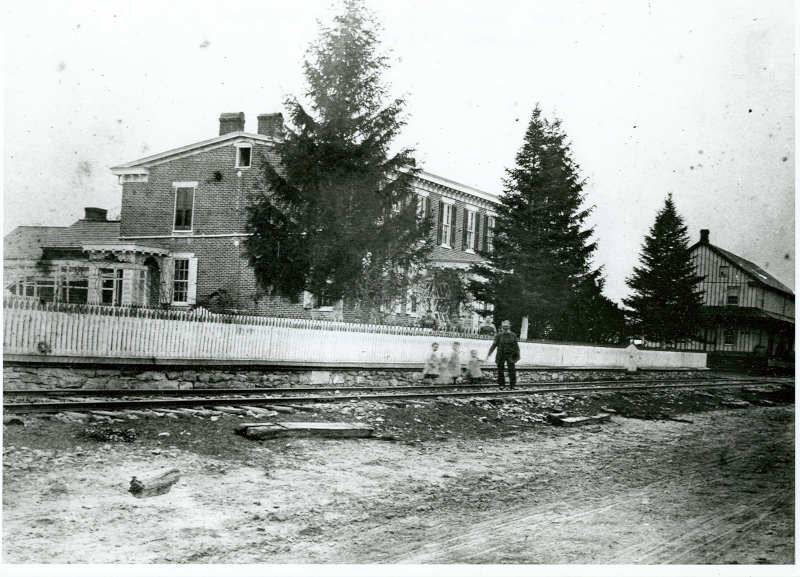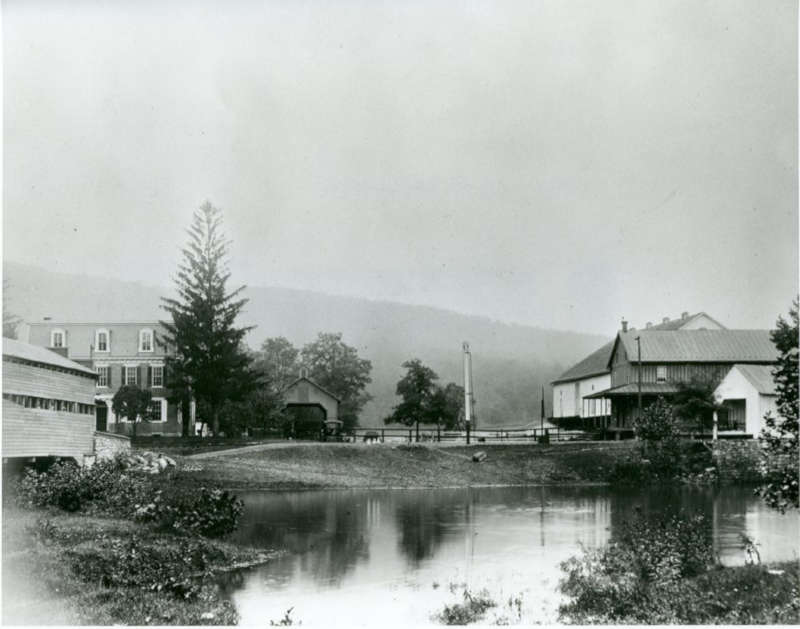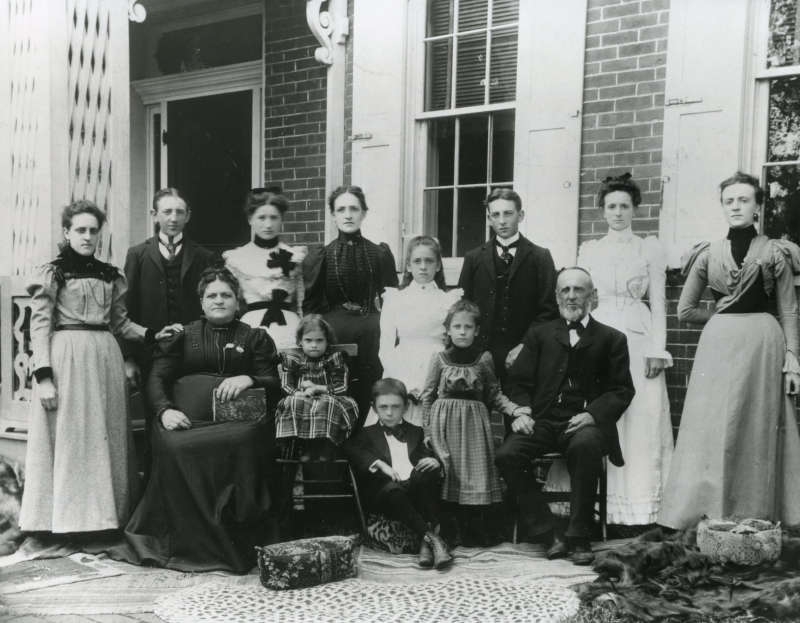Cumberland County Place Names
Cumberland County place names under the following lists: named after the founder or an early settler, geographical/geological features, and miscellaneous.



Top: Brandt House c. 1880s. The man in the photo is likely Michael G. Brandt, George’s father (37F-00-01).
Middle: Brandt House after the addition of third floor in 1894. Note the Railroad Station and covered bridge. None of these structures survive (37F-00-02).
Bottom: The George M. Brandt family (23A-44-02).
George Brandt’s elegant brick mansion house stood just across the Yellow Breeches Creek at a bend in the road to Dillsburg (present day Route 74). Mature trees were set against the backdrop of the mountain to the south and a covered bridge which crossed the creek to the north. Between the covered bridge and the mansion house were the railroad tracks. They would be the site of several tragedies to come.
George grew up in the house at Brandtsville. Brandtsville, or Brandt’s Station as it was named about 1874, was a depot on the Harrisburg & Potomac Railroad located approximately three miles from Boiling Springs and two miles from Churchtown. It was named for George’s father, Michael G. Brandt who owned the land that had been in the Brandt family since 1765.1 The railroad company built a depot and a warehouse at Brandt’s Station, and in 1879 a post office, named Brandtsville, was established. George Brandt was made its postmaster.2 It closed in 1903 when the rural delivery was established.
George married Mary Catharine Lehman of Boiling Springs in 1872. By 1880, they had four children under the age of six. By 1893, they had eight children ranging in ages from 18 to nine as well as George’s mother, all under one roof. It was time to enlarge the house, and instead of adding on to the back George added a third story with a mansard roof.3 Fortunately, photos survive of the house before and after the alterations.
On September 4, 1902 a massive fire destroyed much of Brandt’s property. At about 3:00 in the afternoon, men were cutting silage when a spark from the traction engine caught a stack of hay on fire. The wind whipped up the fire and the barn and all its contents were destroyed including the warehouse, silos, wagon shed, corn cribs and other out buildings. Miraculously, the house, the bake oven and the milk station were saved. The loss was calculated at about $5,000.4
Forced to sell his cows in September because he had no buildings in which to house them, in November 1902 he had a new and larger barn built on the site of the old one. After the last timbers were erected, the crowd was fed by Mrs. Brandt and her assistants.5
At about 3:00 A.M. on January 6, 1906, “an east-bound freight train jumped the tracks at Brandtsville…ditching 21 cars and an engine, killing the conductor and brakeman, and seriously injuring the engineer and fireman.” The accident occurred directly in front of the warehouse just west of Brandt’s house. Nineteen coal cars piled to a height of nearly fifty feet, and hundreds of tons of coal were scattered onto the tracks. Several of the cars crashed into the warehouse. “The weight of the cars pulled the engine off, and before it went over the big locomotive was standing almost on end.” The Harrisburg and Boiling Springs wrecking crews hurried to the scene to recover the dead and injured men, clear the wreck and repair the track.6 Had the wreck occurred just fifty yards further east, it might have wiped out the Brandt house along with the whole family.
The investigation reported that although the cause of the wreck was unknown, they found the railroad at fault “for having track in such bad condition. In every place the ties are rotten and others the spikes are almost out.”7 Brandt settled his damages suit with the railroad for $30,000 for the land they seized to lay new tracks, sidings, extension, etc.8
He put his mansion and farm up for sale in October 1906. The advertisement stated that the property was on the Philadelphia, Harrisburg and Pittsburg Railroad. It noted that the house would have to be torn down because the road that crossed the bridge in front of the dwelling was to be changed. The farm was in a high state of cultivation with orchards and had been used as a dairy farm. The property also included a new and up-to-date bank barn with attached silo.9
With the sale of the farm to the Philadelphia and Reading Railway Company, Brandt purchased a 60-acre farm in Middlesex Township three miles east of Hickorytown and moved there in March 1907.10
Cumberland County place names under the following lists: named after the founder or an early settler, geographical/geological features, and miscellaneous.
[1] Rev. Conway P. Wing, D.D. History of Cumberland County, Pennsylvania. (Philadelphia: James D. Scott, 1879), 222.
[2] Carlisle, Valley Sentinel, June 20, 1879.
[3] Carlisle Evening Herald, April 5, 1894. Carlisle Evening Herald May 19, 1894.
[4] Carlisle, Sentinel, September 5, 1902.
[5] Carlisle Evening Herald, November 14, 1902.
[6] Harrisburg Telegraph January 6, 1906. Littlestown, Adams County Independent, January 13, 1906
[7] Carlisle Evening Herald, January 9, 1906.
[8] Harrisburg Telegraph January 18, 1906.
[9] Sentinel September 22, 1906.
[10] Carlisle Evening Herald, October 6, 1906.